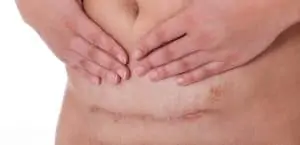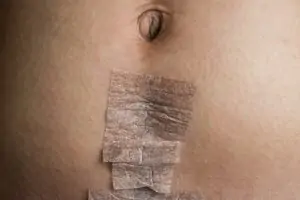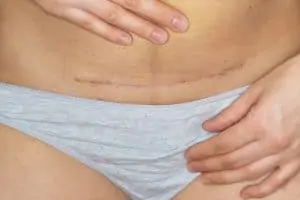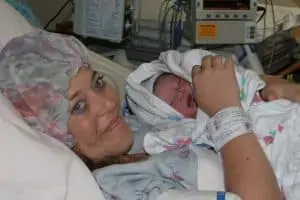Steri strips are the most common form of external closure after a c-section. Often called butterfly closures or butterfly stitches, having steri strips after a c-section help the incision close neater with less discomfort, but what happens when your steri strips don’t fall off within a week?
When you come home from your c-section, good chances are that you will have Steri Strips applied over your incision. Steri Strips, often called butterfly closures or butterfly stitches, are commonly used in a range of surgeries, and they are a comfortable, easy way to keep your incision together.
Here’s my story:
I had steri strips for two of my c-sections, and they didn’t give me too many instructions when I left the hospital. They might have assumed I knew what to do, but I didn’t. Thankfully, my mother is a nurse, so I knew who to call.
Compared to staples, steri strips are more comfortable with less tugging and itchiness. That’s why many mothers prefer them, and providers select them, plus they lead to minimal c-section scars.
You might not have a healthcare provider in your family, so you need to know how to handle your steri strips on c-section incision. It’s a vital piece of c-section incision care. Let’s take a look at what you need to know about having steri strips after a c-section.
What Are Steri Strips?
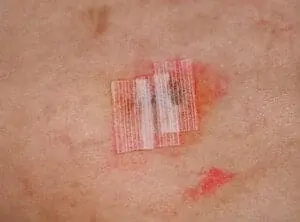
The best way to describe them is that they’re like pieces of tape, but they’re designed to stick to the skin rather than paper or objects. They are 1/8th inch fabric tape that is simple; they aren’t fancy. The basic idea behind the strips is that they push the edges of the wound together, and then the tape holds the wound closed while it heals.
They’re used to close superficial wounds rather than deep incisions, so your doctor will close the bottom layers before using them.
For example, most doctors use absorbable sutures to close your c-section incision before placing the Steri Strips across the layer of skin.
Why Are Steri Strips Used?
Doctors opt for Steri Strips for several reasons. Most patients do prefer them over staples, and they don’t require any specialized removal. The strips hold small areas together that are contoured, such as your stomach, letting the site heal naturally and comfortably.
One of the biggest reasons why Steri Strips are used is that they reduce scarring. Traditional sutures can cause something called ladder rung scars, which most women find unsightly. The use of these strips helps to make a nicer looking scar, which most women do want!
The Pros and Cons
If you’re wondering whether or not Steri Strips are the right choice for your c-section, here are some things to consider.
PROS
- Comfortable for patient
- Creates a less noticeable scar
- Lower risk of skin reactions
- No tugging or pinching
- Easy to care for
- Generally painless
CONS
- Increased risk of wound opening if improperly removed
- Might fall off prematurely
- Not the strongest choice
How to Take Care of Steri Strips?
Caring for these strips is quite easy. You don’t have to do anything special, but be sure to follow them for proper c-section incision care.
It would be best if you left your incision uncovered. Let the soap and water run over your incision while you’re showering, which will help loosen up the strips. Pat them dry after the shower. Don’t try to scrub them off while in the shower; the scrubbing motion can break open scabs.
Here are some suggestions for proper care of the Steri Strips.
- Keep the wound and surrounding skin clean and dry.
- Trim away the edges of any Steri Strips that come loose. Use clean scissors to trim the strips.
- Check your incision each day to look for any signs of infection.
- Never pull or yank on the loose ends of the strips because it could cause the wound to reopen.
If you’re a plus-sized woman and looking for help to keep the area dry, read my post.
How Long Do Steri Strips Stay on After a C-Section?
Without a doubt, the biggest concern for women after their c-section is how long they should stay on the incision site. That was my issue; I had no idea if I should expect them to fall off before my one-week postpartum check-up or if they stayed on longer.
In most cases, your Steri Strips will be removed one week after your c-section, but they often fall off by themselves. If they don’t come off beforehand, be sure to call your doctor and ask if they need to be removed before your post-operation appointment.
Can I Take My Steri Strips Off After a C-Section?
You need to speak to your doctor and ask if it’s a good idea to remove the strips. Some doctors will tell you to remove them all before you arrive for your one-week appointment. Others will tell you to remove them if they’re still present ten days after surgery.
My doctor told me to come in with the strips, and she removed them in the office for me.
One reason that you need to ask your doctor first is that some doctors apply an extra layer of adhesive that keeps the strips securely in place. My doctor did this, and an adhesive remover is required. Otherwise, you could reopen your incision or rip your skin.
How to Remove Steri Strips at Home?
Whatever you do, don’t assume that removing Steri Strips is the same as removing a band-aid. Typically, you use a quick, yanking motion to dismiss band-aids, but if you give that a try with these strips, you could easily remove your skin or cause significant pain.
Start with clean, freshly washed hands, and then follow these steps for removal.
- Start by peeling each strip from one end, just a tiny bit at a time.
- Before you pull the strip, use your other hand and keep the skin stable. You can do this by placing your thumb and forefinger on both sides of the incision.
- Now, slowly pull the strip back until it reaches the incision. Do so in a horizontal motion rather than a vertical movement because that creates more tension on the skin.
- Then, move to the other side and repeat the process. It takes time, so don’t rush it.
- When you are done, pinch both ends and lift gently. If the strips are scabbed over and stuck, don’t pull because removing the scab is a bad idea. Use a damp cotton ball to dab the area. Then try again.
- If, for some reason, the strip refuses to budge – leave it be. Trim the excess piece again so that it doesn’t snag and leave it be for another few days.
Can You Leave Steri-Strips on Too Long?
If your doctor doesn’t remove the steri strips at your one-week post-operation appointment, you might wonder if you can leave steri-strips on too long.
Keeping your steri strips clean is part of c-section incision care. So long as they are kept clean and dry, leaving your steri-strips on for several weeks is generally not a problem.
However, over time, you might notice your c-section incision itching, signaling that it’s time for the strips to come off. They cannot stay on forever, but it’s possible to keep steri strips on for up to six weeks. Most mothers want them removed much sooner.
It’s impossible to keep them on forever, so you cannot keep them on for too long. Steri strips fall off over time, so as long as you have no signs of infection, don’t worry.
Can Steri Strips Cause Infections If Left in Place?
You do need to closely monitor your incision with the strips to watch for infection. The strips need to stay clean and dry because wet strips can trap moisture in your wound. That could allow bacteria to grow, leading to an infection.
Here are some signs of separating or infection that you need to keep an eye out for each day.
- Redness
- Sudden swelling
- Drainage or pus
- Foul odor coming from the site
- Bleeding
- Fever of 101℉
Can You Have an Allergic Reaction to Steri Strips After a C-Section?

Yes, it’s possible to have an allergic reaction to steri strips after a c-section. While it’s not common, some women react to the adhesive on the strips. If the steri strips and c-section is itchy, talk to your doctor about a reaction.
Here are some signs of an allergic reaction to steri strips.
- Bright Redness
- Itchiness
- Hives
- Blisters
- Bumpiness
In most cases, taking an antihistamine reduces the allergic reaction, but be sure to tell your doctor about your reaction. He might decide to remove the steri strips and use a different closure method.
How Do I Know If My C-Section Opened Inside?
A fear that many others have is that their c-section opens inside. Proper c-section incision care reduces the risk of this happening, but knowing the signs to seek medical attention is vital.
This is important:
Call your OBGYN immediately and seek medical care if you experience these signs of your c-section incision opening or becoming infected.
- Bleeding from the incision site
- A fever of 100℉
- Severe pain
- Worsening pain
- Swelling around the incision
- Redness around the site
- Heavy vaginal bleeding
- Bulging or hardness at the incision site
- Large blood clots in vaginal discharge
- Foul-smelling vaginal discharge
- Pus coming from the incision
Final Thoughts
Most doctors do pick Steri Strips after a c-section because of how well they work and how comfortable they are for mothers after surgery. They come off within 7-10 days whether they fall off naturally, you remove them, or your doctor does so. Be sure to watch for signs of infection and let your doctor know if you have any concerns.
Hey, this is Linda. My biggest accomplishment in life is being a mother of four children. Their current ages range from almost ten years old down to 20 months old.
I’m passionate about writing parenting articles because I understand so well all of the problems and trials you face as a parent. From breastfeeding woes to budgeting problems and behavior problems, along with everything in between, chances are I’ve faced it over the last ten years. Read more about Linda here.

